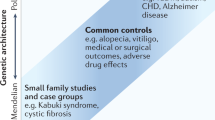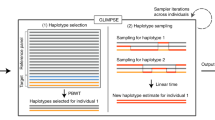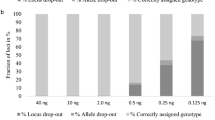Abstract
DNA sequencing is a widely used tool in genetic association study. Sequencing cost remains a major concern in sequencing-based study, although the application of next generation sequencing has dramatically decreased the sequencing cost and increased the efficiency. The choice of sequencing depth and the sequencing sample size will largely determine the final study investment and performance. Many studies have been conducted to find a cost-effective design of sequencing depth that can achieve certain sequencing accuracy using minimal sequencing cost. The strategies previously studied can be classified into two groups: (1) single-stage to sequence all the samples using either high (>~30×) or low (<~10×) sequencing depth; and (2) two-stage to sequence an affordable number of individuals at a high-coverage followed by a large sample of low-coverage sequencing. However, limited studies examined the performance of the medium-coverage (10–30×) sequencing depth for a genetic association study, where the optimum sequencing depth may exist. In this study, using a published simulation framework, we comprehensively compared the medium-coverage sequencing (MCS) to the single- and two-stage high/low-coverage sequencing in terms of the power and type I error of the variant discovery and association testing. We found, given certain sequencing effort, MCS yielded a comparable discovery power and better type I error control compared with the best (highest power) scenarios using other high- and low-coverage single-stage or two-stage designs. However, MCS was not as competent as other designs with respect to the association power, especially for the rare variants and when the sequencing investment was limited.
This is a preview of subscription content, access via your institution
Access options
Subscribe to this journal
Receive 12 print issues and online access
$259.00 per year
only $21.58 per issue
Buy this article
- Purchase on SpringerLink
- Instant access to full article PDF
Prices may be subject to local taxes which are calculated during checkout




Similar content being viewed by others
References
Sims D, Sudbery I, Ilott NE, Heger A, Ponting CP. Sequencing depth and coverage: key considerations in genomic analyses. Nat Rev Genet. 2014;15:121–32.
Goodwin S, McPherson JD, McCombie WR. Coming of age: ten years of next-generation sequencing technologies. Nat Rev Genet. 2016;17:333–51.
Flannick J, Korn JM, Fontanillas P, Grant GB, Banks E, Depristo MA, et al. Efficiency and power as a function of sequence coverage, SNP array density, and imputation. PLoS Comput Biol. 2012;8:e1002604.
Pasaniuc B, Rohland N, McLaren PJ, Garimella K, Zaitlen N, Li H, et al. Extremely low-coverage sequencing and imputation increases power for genome-wide association studies. Nat Genet. 2012;44:631–5.
Shen Y, Song R, Pe’er I. Coverage tradeoffs and power estimation in the design of whole-genome sequencing experiments for detecting association. Bioinformatics. 2011;27:1995–7.
Wu Y, Zheng ZL, Visscher PM, Yang J. Quantifying the mapping precision of genome-wide association studies using whole-genome sequencing data. Genome Biol. 2017;18:86.
Danjou F, Zoledziewska M, Sidore C, Steri M, Busonero F, Maschio A, et al. Genome-wide association analyses based on whole-genome sequencing in Sardinia provide insights into regulation of hemoglobin levels. Nat Genet. 2015;47:1264.
Deelen P, Menelaou A, van Leeuwen EM, Kanterakis A, van Dijk F, Medina-Gomez C, et al. Improved imputation quality of low-frequency and rare variants in European samples using the ‘Genome of The Netherlands’. Eur J Hum Genet. 2014;22:1321–6.
Kreiner-Moller E, Medina-Gomez C, Uitterlinden AG, Rivadeneira F, Estrada K. Improving accuracy of rare variant imputation with a two-step imputation approach. Eur J Hum Genet. 2015;23:395–400.
Li Y, Sidore C, Kang HM, Boehnke M, Abecasis GR. Low-coverage sequencing: implications for design of complex trait association studies. Genome Res. 2011;21:940–51.
Xu C, Wu K, Zhang JG, Shen H, Deng HW. Low-, high-coverage, and two-stage DNA sequencing in the design of the genetic association study. Genet Epidemiol. 2017;41:187–97.
Nielsen R, Paul JS, Albrechtsen A, Song YS. Genotype and SNP calling from next-generation sequencing data. Nat Rev Genet. 2011;12:443–51.
Gilly A, Suveges D, Kuchenbaecker K, Pollard M, Southam L, Hatzikotoulas K, et al. Cohort-wide deep whole genome sequencing and the allelic architecture of complex traits. Nat Commun. 2018;9:4674.
Huang W, Li L, Myers JR, Marth GT. ART: a next-generation sequencing read simulator. Bioinformatics. 2012;28:593–4.
Centers for Disease C. Prevention: National Diabetes Statistics Report: estimates of diabetes and its burden in the United States. Atlanta, GA: US Department of Health and Human Services; 2014.
Su Z, Marchini J, Donnelly P. HAPGEN2: simulation of multiple disease SNPs. Bioinformatics. 2011;27:2304–5.
Purcell S, Neale B, Todd-Brown K, Thomas L, Ferreira MA, Bender D, et al. PLINK: a tool set for whole-genome association and population-based linkage analyses. Am J Hum Genet. 2007;81:559–75.
Wu MC, Lee S, Cai T, Li Y, Boehnke M, Lin X. Rare-variant association testing for sequencing data with the sequence kernel association test. Am J Hum Genet. 2011;89:82–93.
Wetterstrand KA. DNA sequencing costs: data from the NHGRI Genome Sequencing Program (GSP); 2016. https://www.genome.gov/about-genomics/fact-sheets/Sequencing-Human-Genome-cost.
Zhang L, Bai W, Yuan N, Du Z. Comprehensively benchmarking applications for detecting copy number variation. PLoS Comput Biol. 2019;15:e1007069.
Acknowledgements
The work was partially supported by grants from the National Institutes of Health (R01 AR059781, R01 MH104680, R01 AR069055, U19 AG055373, and P20GM109036), Edward G. Schlieder Endowment, and startup funds from Tulane University. This research was supported in part using high performance computing (HPC) resources and services provided by Technology Services at Tulane University, New Orleans, LA.
Author information
Authors and Affiliations
Corresponding author
Ethics declarations
Conflict of interest
The authors declare that they have no conflict of interest.
Additional information
Publisher’s note Springer Nature remains neutral with regard to jurisdictional claims in published maps and institutional affiliations.
Supplementary information
Rights and permissions
About this article
Cite this article
Xu, C., Zhang, R., Shen, H. et al. Medium-coverage DNA sequencing in the design of the genetic association study. Eur J Hum Genet 28, 1459–1466 (2020). https://doi.org/10.1038/s41431-020-0656-2
Received:
Revised:
Accepted:
Published:
Issue date:
DOI: https://doi.org/10.1038/s41431-020-0656-2



